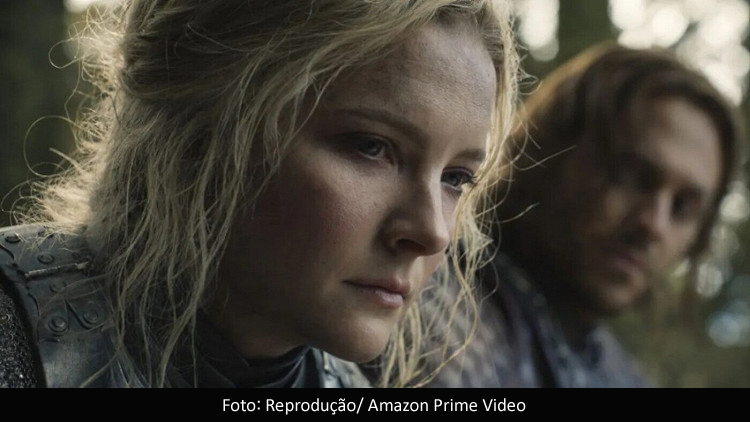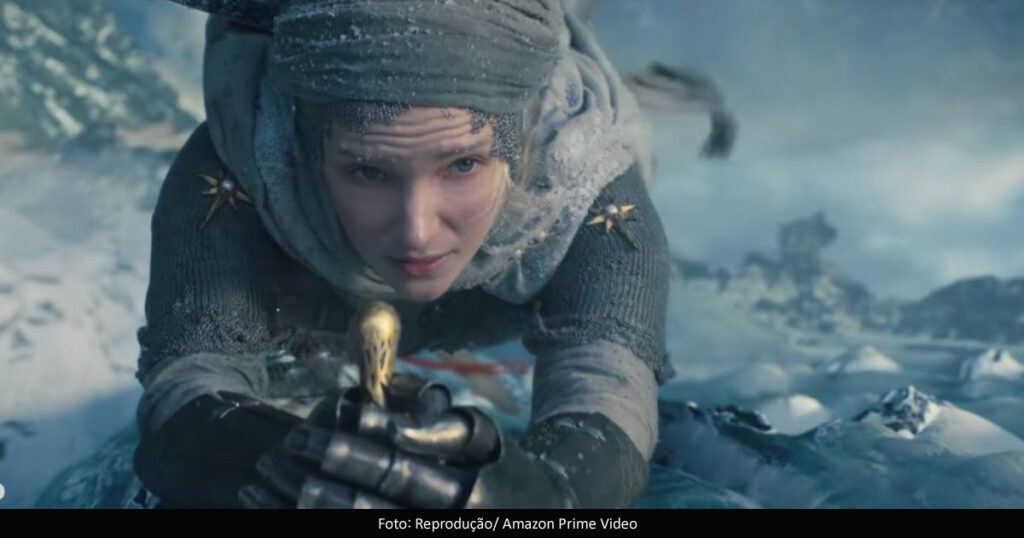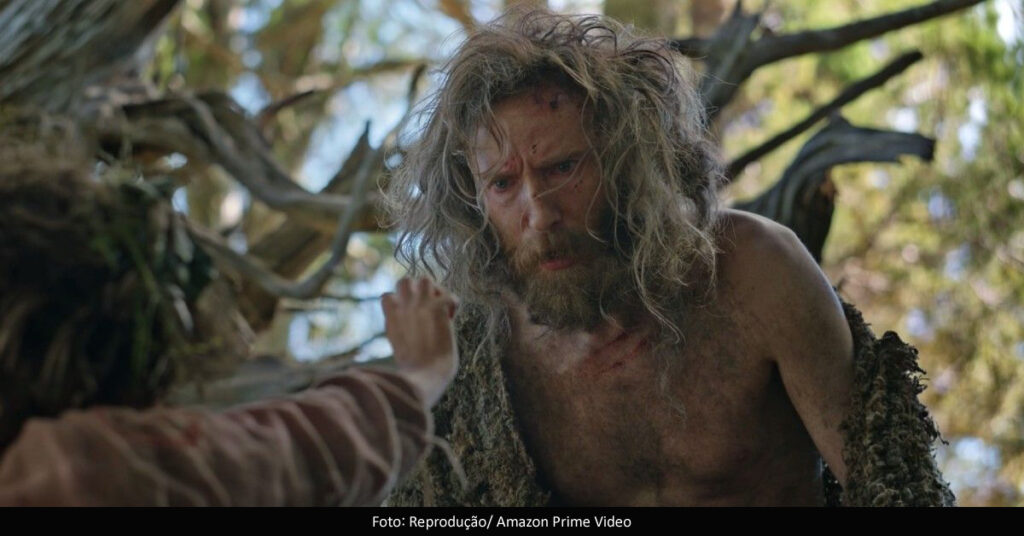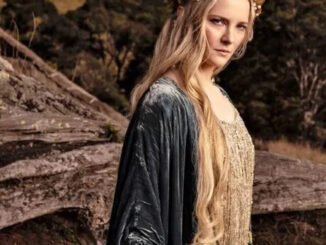By Luana Rufino

The series inspired by Tolkien’s universe, The Lord of the Rings – The Rings of Power, has already become, in less than a month, the most popular in the world. The purpose of this article is to identify and explain some elements of Professor J. R. R. Tolkien‘s work so that everyone can follow, understand and draw their own conclusions about the newest series inspired by Tolkien’s legendary.
For fans who read The Silmarillion, they have already identified that the opening of the series brings with it the movement of the sands over a black sound box that forms the images of the rings at the end. This reflects the beginning of creation when the creator Ilúvatar (Eru) proposes to the Ainur (kind of angels) a theme of music: the creation of the Ainulindalë (The Wonderful Symphony). Therefore, a positive point for the intelligent opening of the series that in a simple way, through cymatics, shows how the movement of sound waves modify and transform matter (sand) expressing how the Great Music (Ainulindalë) created the world of Arda (Eä) from the inspiration and freedom of the Valar (Ainur who descended to Eä). It is the Mystery of the relationship between the individual and the collectivity that emerges as a fundamental theme: “unity”. The Polyphony of Creation refers to this beautiful myth that opens The Silmarillion, for which there are many different voices, but which sing together in a single common music.
Another positive impact is the opening sentence of the series, in its first episode, said by Galadriel:
“Nothing is evil in the beginning. And, there was a time, when the world was so young that the dawn didn’t even exist. Still, there was light.”
This first opening sentence of the series told by Galadriel brings with it a deep characteristic of Tolkien’s thought that, in its origin or in its beginning – either from the creation of the world of Eä, or the beings that will inhabit it, or from the beginning of his mission – all is good, all creation was made for a good. However, the departure from this origin allows the entry of evil into creation, as well as its corruption that will be so well developed in Tolkien’s legendarium.
With that, the generation, the creation, anything that has reality, anything that has life, anything that has consistency of being is something that comes from deep within Ilúvatar (Eru) himself. Evil creates nothing, evil only distorts, it is a dissonance, a partiality that does not consider reality in all its factors. As can be seen in the orcs that are not original creatures of the Valar, but are the corruption of the elves, they are something corrupted. This brings us to the unfolding that any creative effort that a being of Eä makes can only be good and positive where He comes from. This is profoundly modern in Tolkien: the true power of Eru, in his proposal of creation, does not consist in generating himself, period, but in integrating what are the efforts of all his sub-creators (from the Ainur to all peoples of Eä) in His personal design.
Therefore, it is a true position about Tolkien’s imagination, and also a way of looking at the diversity of the other, there is not an attitude of combat, battle or aggressive violence, but of appreciation, integration and deepening. Thus, in any being that strives to create something beautiful in Eä, there is Eru behind his Great Music.
Indeed, this extraordinarily modern foundation of Tolkien’s legendarium shows how deeply different characters, physically, culturally and with totally different ideals are able to come together in search of a common good. This Mission shared by so many different peoples and which goes beyond the intense rivalry between them shows that, between fights, betrayals and failures, there is a good that is revealed in anyone without distinction. In every breathing being, from different peoples, something can arise that makes the creation of something beautiful in the world.
For this reason, I found it very positive for the series to innovate in this and, particularly, I really enjoyed seeing more diversity in the physical characteristics of these peoples – with elves, dwarves and black men – because it helps us to better understand Professor Tolkien’s teaching about diversity. The relationship with diversity – and with the difference of the other – is one of the great themes addressed in his legendarium. And, in this sense, Tolkien tells us that diversity is one of the greatest signs of the free and deep love that Ilúvatar has for his creation, the acceptance of the other. It is an act of pure acceptance of the freedom and difference of creation. Thus, Tolkien shows that, to really discover the mission that was given to Eä, it is necessary to be open to everyone, without distinction.
With this, another interesting aspect of the Series is to see how several new characters are revealed gradually and simultaneously, very characteristic of the narrative of Professor J. R. R. Tolkien, who from a common plot unfolds his characters in missions (demands) of their own and totally free. Precisely due to the freedom and autonomy of these characters, new links emerge and multiply, as in the Valar tree, presented in the opening scenes with its various ramifications, but linked to a single trunk. This, in addition to increasing the complexity of this masterpiece, also shows how several seemingly disconnected and random personal stories in the background have a common origin. And the unfolding of the story reveals not only a creative power in each character, but the integration of the various efforts and individual personalities in a unique destiny, apparently unimaginable and impossible.
Now, moving on to the most controversial point, which generated a lot of debates in this first episode of the series: the construction of Galadriel’s arc. Initially, let’s see what Tolkien himself said about her personality:
“Galadriel was the greatest of the Noldor, save perhaps for Fëanor, though she was wiser than he, and her wisdom increased with long years.”
“Her origin name was Nerwen (“man-maiden”), and she grew to a height beyond the measure even of the men of the Noldor; she was strong of body, mind, and will, rivaling both the sages and the athletes of the Eldar.”
“She was proud, strong and willful.”
“Galadriel was born into the bliss of Valinor, but it was not long, by the count of the Blessed Realm, until it waned; and from that point on she had no inner peace.”
“Indwelt in her the noble and generous spirit of the Vanyar, as well as a reverence for the Valar that she could not forget … she had a wonderful gift of penetrating the minds of others.”
“Galadriel, the greatest of the Eldar that survived in Middle-earth, had her chief potency in wisdom and kindness, as warden and adviser in combat, unconquerable in resistance.
«Galadriel had in this point more insight than Celeborn, and she saw at once that Middle-earth could not be saved from the ‘residue of evil’ which Morgoth had left behind, except by a union of all peoples who in their own way and in their measure they opposed him. She also saw the Dwarves with the eyes of a commander, seeing in them the best warriors to be sent against the Orcs.” [J. R. R. Tolkien, Unfinished Tales]
“Galadriel, the only woman of the Noldor to stand that day, tall and valiant among the fighting and contending princes, was eager to depart.”
“Queen was she of the Wood Elves, wife of Celeborn of Doriath, but she herself came from the Noldor and remembered the Day before the days of Valinor, and she was the mightiest and fairest of all the Elves that remained in Middle-earth.” [J. R. R. Tolkien, The Silmarillion]
From these writings by J. R. R. Tolkien, we can understand that the Galadriel presented in the series, in the two first Ages, is quite different from the more experienced and wiser that many are familiar with in the Lord of the Rings books (or movies). With this, it seems, the series will explore this journey of maturity of Galadriel who, as Tolkien writes, was a proud, strong, willful and combative elf.

In view of these characteristics of Galadriel, to which Christopher Tolkien himself admits the gaps contained in her story, the series creates a reason for Galadriel’s departure to Middle-earth motivated by revenge for the death of her brother. This most rebellious Galadriel with a thirst for revenge against Sauron, despite being different from what we are used to, does not contradict the professor’s writings, as we can see:
“Thus it came to pass, that when the light of Valinor was gone forever, as the Noldor thought, Galadriel joined the rebellion against the Valar that bid them stay; and, once she had set foot on that path, she would not turn back and she rejected the last message of the Valar, thus incurring the Sentence of Mandos.”
“Her pride refused to allow her to return defeated, begging for forgiveness; now, however, she burned with a desire to follow Fëanor, wrathfully, to whatever lands he came to, and to frustrate him in any way she could.”
“Pride still moved her when, at the end of the Elder Days, after the last fall of Morgoth, she refused the pardon of the Valar for all who had fought, and remained in Middle-earth.”
“Only after two more long ages had passed, when at last all that she had desired in youth came into her hands, the Ring of Power and the dominion of Middle-earth she had dreamed of, did her wisdom become full and she everything rejected. And, in passing that last test, he departed Middle-earth forever.”
“Galadriel, in efforts to counteract Sauron’s machinations, succeeded in Lórinand.”
“In Eregion Sauron posed as an emissary of the Valar, sent by them to Middle-earth … he perceived at once that Galadriel would be his chief adversary and obstacle, and therefore endeavored to appease her, enduring the contempt of her with apparent patience and courtesy.”
“In Lórinand, Galadriel assumed power and defense against Sauron.” [J. R. R. Tolkien, Unfinished Tales]
“Nearby – replied Galadriel – except that we were not driven out, but we came of our own accord and against that of the Valar. And through great peril and against the Valar for this purpose we have come: to obtain vengeance on Morgoth, and to recover what he stole.” [J. R. R. Tolkien, The Silmarillion]
In this sense, what we can expect from the series going forward regarding the opening of this new arc for Galadriel is her path of maturity. We can also understand this in the beautiful dialogue between Galadriel and her brother Finrod presented in the series: “Do you know why the boat floats and the stone does not? Because the stone only looks down, the darkness of the water is immense and irresistible, the boat also perceives the darkness that tries at every moment to dominate and sink it. But the boat has a secret, its gaze is upwards, not downwards, it is fixed on the light that guides it and promises wonders that the darkness does not know”. In response to her brother in this dialogue, she replies that sometimes the reflection of light from water is as bright as light from the sky, to which her brother replies, “There are times we cannot know until we have touched the darkness.”
In this way, we can understand Galadriel’s decision here as a journey of someone who has to understand what darkness is and go to the subterranean of herself to return to the light, that is, a true path of redemption. That is, to return to the Beauty of the origin, she will go the opposite way, touching to the depths of the darkness she has within herself.
The certainty grows within Galadriel that her heart has a desire (a mission), and she is so faithful to this that she reaches the point of resignation that is the splendor of inhabiting Valinor, in the series marked by her decision to jump from the boat to the end of the first episode. According to Christopher Tolkien:
“What is most remarkable (…) is the explicit statement that Galadriel refused the pardon of the Valar at the end of the First Age.”
“Galadriel, now despairing of Valinor (…) sailed through the darkness without waiting for the permission of Manwë (Ainur), which at that hour would doubtless have been denied her, however legitimate her wish was in itself. Thus she was included in the ban on all departures, and Valinor was closed to her return.”
“Galadriel’s remaining in Middle-earth after Sauron’s defeat in Eriador is attributed to her judgment that it was her duty not to depart until he was definitively defeated.”
“Galadriel realized at once that Middle-earth could not be saved from the residue of evil which Morgoth had left behind, except by a union of all peoples who in their way and in their measure opposed him. She also saw the Dwarves with the eyes of a commander, seeing in them the best warriors to be sent against the Orcs.”
[Unfinished Tales]
It is in this context, therefore, that we see some decisions made by Galadriel and its importance in this story, an arc that occupied most of the first episodes. As this story unfolds, in Middle-earth, a mysterious man falls from a star near Nori, a member of the Hairfoot, precursors of the Hobbits:
Before crossing the mountains, the Hobbits had already divided into three rather different strains: Hairyfeet, Grados and Cascalvas. The hairy feet were darker in skin, smaller and shorter, they were beardless and didn’t wear boots. They were the most normal and representative variety of Hobbits, and by far the most numerous. They were the most inclined to settle in one place and for the longest time preserved their ancestral habit of living in tunnels and burrows.
[J. R. R. Tolkien, Prologue – The Lord of the Rings]
This man featured in the series, coming from a kind of shooting star that falls on Arda, is perceived as the sign of something. We know that all the characters are in the same moment in time precisely because they all look at this sign that appears in the sky, in the form of this shooting star. And the place “chosen” for this shooting star to stay is also an enigma, because it is precisely with this small people. Of all places, the star falls right next to the little walkers, a small people on the journey.

Nori, who meets the mystery man for the first time, intuits that this encounter was not an occasional one and tells Poppy, “I feel responsible for him. This is different, he could have landed anywhere, but he landed here. I know you’ll think it’s weird, but I know that somehow he’s important. There is a reason this to happen, and I was chosen to meet him. I. And I can’t ignore it.“
There are many theories as to who this mysterious man is, Gandalf himself as we know him, or another Istari who has taken corporeal form sent by the Valar to aid in the mission for Arda. In this regard, I will highlight a few points. First, Gandalf who was the “personification of Grace”, as Tolkien said in one of his letters, was the bearer of the secret fire of the Valar: a fire that does not consume, but that rises.
Therefore, unlike Sauron whose fire destroys, secret fire is hidden, and because it is a holy fire it does not burn or hurt anyone who touches it. In this sense, we see that Nori, when touches the fire in which the man is wrapped, does not get burned. Also the man shouts to Nori “màna úrë” which means “sacred fire”.
The power, size and old age of this mysterious man is contrasted with Nori’s simplicity, smallness and youth. However, this man needs the help of precisely this small character, who, even small and without powers, feels responsible for him in some way. Nori, without understanding yet, feels impelled to go to the bottom of an individual journey on a path with him, a journey and not the realization of a project, but the “revealing” of something deeply alive and hidden in her small people, an unknown and secret weapon.
Another indication that he may be Gandalf is his name by the elves “Mithrandir” which means “Pilgrim / Gray Wanderer“, which may be a reference to the reason why he became a wanderer since he arrived at Eä. The interesting thing was to see in the series how it was a surprise for Nori, but also for him, the fact that they were right there. Was it intentional by the Valar?! This we will discover on the way to this small/big and beautiful friendship!
And speaking of friendship and beauty, high point for the relationship full of demands and ferocity, but at the same time full of tenderness and affection between Elrond and Durin! Although not portrayed in the books, Tolkien states that in the Second Age, the relationship between these different peoples was more of a friendship than we see in the Third Age. With that, we once again follow this unusual and fun union between Elves and Dwarves.
Finally, what we have been able to observe so far, among the various and contradictory comments about the series, is the fact that the series contains Beauty. As the elf Arondir said “Beauty has the power to heal the soul“. I consider this thought to be deeply linked to Professor Tolkien who, in one of his letters to his student about the Lord of the Rings book, says “I’m very glad you liked it because the starting point of the book is Beauty. I wrote this work to be beautiful and appreciated.” It is precisely because of its gratuitousness – which is the cipher of Eru’s form of action – that something true can emerge in it. Therefore, for Tolkien, the truest approach is the one drawn to Beauty, with the courage to be impressed by Beauty, not just what is comforting or already understood. This is because, for any creation of the human imagination, if it is done with purity and humility, it will be donated, reality will be given to it, it is a gift that arises spontaneously from the freedom of these new characters in creation. As Professor Tolkien says: “Thus, just as Eru spoke, a Beauty not yet conceived will come to Eä, and it will still be good that evil has existed.”
Original post available at Comunhão e Libertação


I liked the text, the author demonstrates a deep knowledge! congratulations!
Very good! Excellent explanation!
Wow! What a great review! Looking foward for more insights!